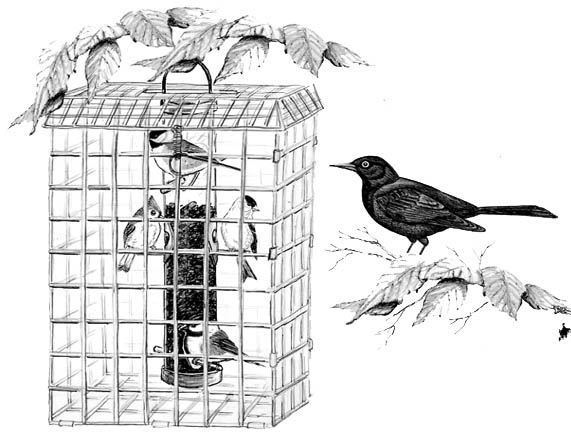
Dear Bird Folks,
With the ever-rising price of birdseed, I’d like to know how I can get rid of those darn crows that keep hanging onto my feeders all day. I’ve tried cutting and even removing the perches, but they hang on with one leg, flap their wings and eat, nonstop. I’m sure you are going to tell me that a bird is a bird and I should like them all, but I hate these pigs. How do I get rid of them?
– Thelma, Groton, CT
Calm down, Thelma,
Count to ten, take a deep breath, and go get yourself a piece of chocolate. Go ahead. I’ll wait. Feel better? Now that your fit has subsided, I have some good news for you: The birds that have you so upset aren’t crows. Crows have way too much style and sophistication to be seen hanging on a feeder with one leg. The birds that are dominating your feeders are most likely Common Grackles. Grackles, which look a bit like tiny crows, with purplish iridescent heads and bright yellow eyes, have become, thanks to our clear-cutting ways, one of the most abundant birds in North America. They are also one our most misidentified birds. In addition to being called “crows,” some people, including my own mother, call them “starlings.” Starlings? They don’t even look like starlings, yet lots of people call them that. Apparently, my mother has more influence than I give her credit for. The one that really amazes me is when I hear people call them “crackles.” That’s right, crackles. I think they are confusing birds with breakfast cereal or really cheap fireworks.
Although crows will visit our feeders, they are typically very cautious, slow and respectful of their fellow crows. Grackles, on the other hand, often come in waves, hitting feeders like football players diving on a fumble. When grackles arrive there’s always a lot of squawking and squabbling, with each bird behaving like it’s the last meal that it will ever see. And even though crows are one our most intelligent birds, they don’t display any of the feeder-balancing skills that grackles possess. As you know, a grackle can eat from a feeder with a long perch, a short perch, or no perch at all. When it comes to finding new and clever ways to exploit a bird feeder, only the grand master of feeder thievery, the Eastern Gray Squirrel, can match the skills of the Common Grackle. But there are a few things you can try that may save you some seed and in turn, may stop your cycle of hate.
First, try offering safflower seed in a feeder by itself, and not mixed in with other seed. Safflower is not a repellant, but it is one of the grackles’ least favorite foods. More often than not, they’ll leave it alone…but not always. I have many customers who swear by it, others who swear at it, and others who swear for no apparent reason at all. I suggest trying a few pounds of safflower, use it for a few weeks and then evaluate the results. If safflower works, great. If it doesn’t work, then just start swearing or try the next suggestion.
Some fancy bird feeders have feeding perches that, if adjusted right, will prevent heavy birds from eating. Through trial and error you may be able to adjust them to keep out grackles most of the time. It’s important to note the phrase, “most of the time.” As I mentioned earlier, grackles are very agile. By flapping and clinging, they will sometimes manage to get a few seeds. If seeing a grackle taking the occasional bit of food still upsets you, and counting to ten and eating chocolate have stopped keeping you calm, then it’s time to invest in the ultimate grackle protection.
Twenty years ago, after tiring of all the grackle complaints, I hired a team of engineers from MIT to design a truly grackle-proof feeder. After hundreds of hours of research and millions of dollars spent on prototypes, the Mega-ugly Green Cage was born. As the name implies, the Mega-ugly Green Cage isn’t the best looking item you’ve ever had in your yard, but it works. The small birds fly through the cage, while the much larger grackles are kept out. In recent years several feeder manufacturers have produced their own feeders with cages to keep out grackles. Some work great, others don’t. So, before you lay down your cash on an expensive grackle-proof feeder, you should check with a knowledgeable feeder person, or at least a smart friend, or at the very least a know-it-all neighbor.
To begin your anti-grackle campaign, Thelma, I think you should start by offering safflower seed, in a feeder by itself and not mixed with other seed. If that works, you are good to go. If it doesn’t work, then it is time to buy some kind of cage feeder, if you don’t mind the ugliness. One last thing. In case you hadn’t figured it out, the part about the Mega-ugly Green Cage being developed after hours of research at MIT is a bit of stretch. It was actually invented in the physics lab at Princeton University, but I thought the MIT version made for a better story.